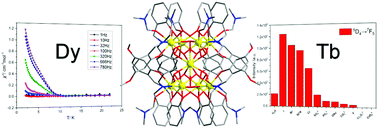The utilization of a Schiff base ligand 2-((2-hydroxy-4-methoxy-benzylideneamino)methyl)phenol (H2L) afforded five nonanuclear lanthanide(III) clusters of formula [Ln9L8(μ3-OH)8(μ5-O)2(DMF)8][H3O]·nH2O (Ln = Eu, n = 1 (1[H3O]·H2O); Ln = Gd, n = 4 (2[H3O]·4H2O); Ln = Tb, n = 3 (3[H3O]·3H2O); Ln = Dy, n = 6 (4[H3O]·6H2O); Ln = Ho, n = 2 (5[H3O]·2H2O)). Single-crystal X-ray diffraction analysis revealed that all of the complexes were isomorphous and had a diabolo-like topology. The intriguing Ln9 core was constructed by two square pyramidal units that shared a vertex metal centre. Variable-temperature dc magnetic susceptibility studies indicated weak antiferromagnetic interactions for 2[H3O]·4H2O, 3[H3O]·3H2O, 4[H3O]·6H2O and 5[H3O]·2H2O. The DyIII9 cluster displayed a slow relaxation of magnetization. Fluorescence measurements revealed an intense green photoluminescence for the TbIII9 compound. The luminescence tests showed that the TbIII9 analogue could perform as a highly sensitive, selective and recyclable luminescence sensing material for Fe3+, CrO42− and Cr2O72−. In this work, the H2L ligand was derived by finely modifying the previously designed compounds (((2-hydroxy-3-methoxybenzyl)imino)methyl)-6-ethoxyphenol and (((2-hydroxy-3-methoxybenzyl)imino)methyl)-6-methoxyphenol, from which the Ln2 and Ln4 clusters were successfully prepared and reported. Noticeably, the decisive decrease in the steric hindrance of the predesigned ligands resulted in the expansion of the nuclearity. This work demonstrated the synthetic potential for assembling the large clusters by rationally decreasing the steric hindrance of the analogous ligands.

